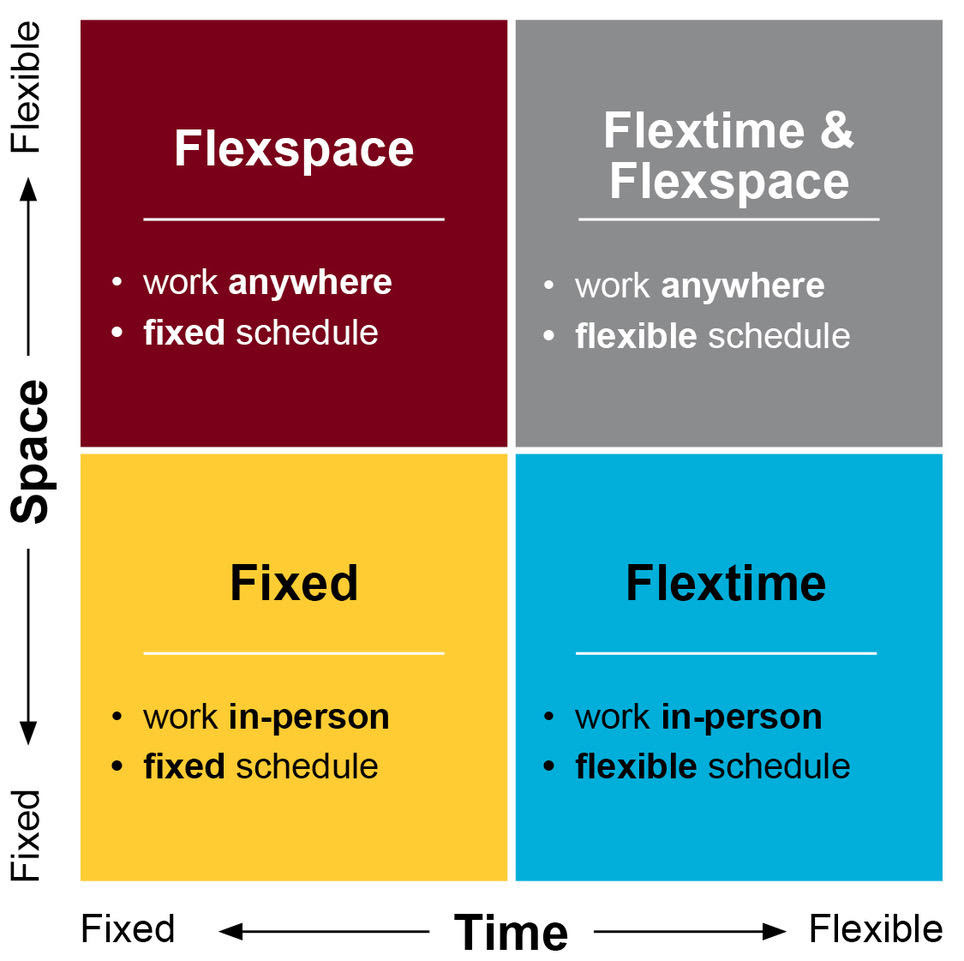
Adapting to a Culture of Flexible Work
Published on June 10, 2021.
Key Insights
- Flexible work is here to stay
- Prepare for flexible work by understanding options, evaluating job responsibilities, gathering input, and ensuring equity

While the days when everyone can safely gather and work in person are in sight, the days of the in office 9-to-5 grind are in the past. The COVID-19 pandemic has shown us that work is not about where we go. Work is first about what we do, followed by how, when, and where we do it.
Some faculty and staff are encouraged by the apparent benefits of a flexible work culture: reduced stress, improved wellbeing, and increased job performance and satisfaction. After more than a year of successfully operating with a hybrid workforce, the University supports ongoing flexibility in the way we work.
If you haven't already, in the coming weeks and months you will begin to hear more about the type of flexibility your college or unit will support, and the health and safety measures that will be in place for those returning to campus.
Prepare your teams for flexible work
Each college and unit has different needs and priorities, and therefore different perspectives on flexibility. Before you begin discussions with your team, be sure to check with your local leaders and human resources representative to understand your local plan and how it will be implemented.
Understand Flexible Work Options
Flexible work refers to both when and where work takes place. Options can either be defined individually or combined:

Evaluate the Nature of the Work
Not all positions or job responsibilities are compatible with flexible work arrangements, therefore the work must inform decisions about where and when it will take place. Keep these tips in mind as you think about flexible work arrangements for your team:
- Prioritize the advancement of our mission as we serve students, faculty and staff, and the community.
- Consider both individual and team productivity.
- Determine the type of work that can be made flexible as well as the work that must take place on site or at a specific time (e.g., clinical work, custodial work).
- Consider making changes to how work is done. For example, can appointments or meetings that once took place in person be moved to a virtual platform? Can working or office hours be adjusted or staggered to allow flexibility without compromising customer service?
Understand Individual Preferences and Needs
Flexible work arrangements should include some input from employees. Talk with your faculty and staff about how they prefer to work. When are they most productive? Where are they most productive? What personal needs do they have that flexible work could accommodate?
Listen for needs that may require additional assistance from your unit HR, Disability Resource Center, or a similar service, to resolve, such as ergonomics, or health and safety protocols.
Be careful not to make promises of flexible work arrangements to individuals before you understand the boundaries within your college or unit and how each individual’s preference will affect your team’s ability to move work forward.
Transitioning to a flexible work culture will be an iterative process where new information and experiences will call for improvements and adjustments. Challenge yourself to think about how to shift tasks and responsibilities to allow for more flexibility.
Commit to Equity and Understand Your Biases
Ensuring equity is a major challenge for flexible work, but it can be mitigated if done with intention. Basing decisions on your college or unit’s FWA boundaries and on job responsibilities, rather than individual preferences, is the first step toward equity.
Bring awareness to other types of bias that could affect your decisions:
- Affinity bias—Giving preferential treatment to someone because they share similar experiences or remind you of someone you know and like.
- Recency bias—Giving recent situations, events, or information more weight and importance than older ones.
- Confirmation bias—Seeking or taking in new information to confirm your own beliefs.
- Consensus bias—Assuming your own thoughts, choices, and judgments are common and shared with others.
This level of workplace flexibility is new for a lot of colleges and units and will involve trial, error, and evolution. Just as COVID has shown us that we can work with flexibility, it has also shown us that we’re adaptable and resilient in times of change.

Managing Flexible Teams Webinar, June 16, Noon–1:00 p.m.
One of the biggest lessons we’ve learned during the past year is that work is about what we do, not necessarily where we do it. In this webinar, we’ll cover topics to help you implement flexible work arrangements on your team, and give you tools to manage employees with different flexible work plans.
During the webinar you will learn to:
- Distinguish between the different types and benefits of flexible work arrangements, including in-person, hybrid, and remote work.
- Analyze the needs of your work, team, and individual employees to make decisions about flexible work that make sense for them.
- Employ key supervisory skills to effectively manage and engage remote or hybrid team.